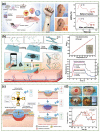Wearable Sensors and Systems for Wound Healing-Related pH and Temperature Detection
- PMID: 33919752
- PMCID: PMC8070747
- DOI: 10.3390/mi12040430
Wearable Sensors and Systems for Wound Healing-Related pH and Temperature Detection
Abstract
Wound healing is a complex tissue regeneration process involving many changes in multiple physiological parameters. The pH and temperature of a wound site have long been recognized as important biomarkers for assessing wound healing status. For effective wound management, wound dressings integrated with wearable sensors and systems used for continuous monitoring of pH and temperature have received much attention in recent years. Herein, recent advances in the development of wearable pH and temperature sensors and systems based on different sensing mechanisms for wound status monitoring and treatment are comprehensively summarized. Challenges in the areas of sensing performance, infection identification threshold, large-area 3-dimensional detection, and long-term reliable monitoring in current wearable sensors/systems and emerging solutions are emphasized, providing critical insights into the development of wearable sensors and systems for wound healing monitoring and management.
Keywords: pH; smart systems; temperature; wearable sensor; wound management.
Conflict of interest statement
The authors declare no conflict of interest.
Figures






Similar articles
-
Advances in Wearable Biosensors for Wound Healing and Infection Monitoring.Biosensors (Basel). 2025 Feb 23;15(3):139. doi: 10.3390/bios15030139. Biosensors (Basel). 2025. PMID: 40136936 Free PMC article. Review.
-
A recent review on smart sensor-integrated wound dressings: Real-time monitoring and on-demand therapeutic delivery.Int J Biol Macromol. 2025 Jun;313:144251. doi: 10.1016/j.ijbiomac.2025.144251. Epub 2025 May 15. Int J Biol Macromol. 2025. PMID: 40381780 Review.
-
A Review of Recent Advances in Flexible Wearable Sensors for Wound Detection Based on Optical and Electrical Sensing.Biosensors (Basel). 2021 Dec 23;12(1):10. doi: 10.3390/bios12010010. Biosensors (Basel). 2021. PMID: 35049637 Free PMC article. Review.
-
Multifunctional Dressing for Wound Diagnosis and Rehabilitation.Adv Healthc Mater. 2021 Nov;10(22):e2101292. doi: 10.1002/adhm.202101292. Epub 2021 Jul 26. Adv Healthc Mater. 2021. PMID: 34310078
-
Recent advances in biosensors for real time monitoring of pH, temperature, and oxygen in chronic wounds.Mater Today Bio. 2023 Aug 19;22:100764. doi: 10.1016/j.mtbio.2023.100764. eCollection 2023 Oct. Mater Today Bio. 2023. PMID: 37674780 Free PMC article. Review.
Cited by
-
Conducting polymer functionalization in search of advanced materials in ionometry: ion-selective electrodes and optodes.RSC Adv. 2024 Aug 13;14(35):25516-25548. doi: 10.1039/d4ra02615b. eCollection 2024 Aug 12. RSC Adv. 2024. PMID: 39139237 Free PMC article. Review.
-
Smart drug delivery and responsive microneedles for wound healing.Mater Today Bio. 2024 Oct 29;29:101321. doi: 10.1016/j.mtbio.2024.101321. eCollection 2024 Dec. Mater Today Bio. 2024. PMID: 39554838 Free PMC article. Review.
-
Enhancing wound healing through deep reinforcement learning for optimal therapeutics.R Soc Open Sci. 2024 Jul 31;11(7):240228. doi: 10.1098/rsos.240228. eCollection 2024 Jul. R Soc Open Sci. 2024. PMID: 39086835 Free PMC article.
-
Multimodal Wireless Wound Sensors via Higher-Order Parity-Time Symmetry.IEEE Sens J. 2024 Jan;24(1):741-749. doi: 10.1109/jsen.2023.3333292. Epub 2023 Nov 21. IEEE Sens J. 2024. PMID: 38344259 Free PMC article.
-
Research on Flexible Sensors for Wearable Devices: A Review.Nanomaterials (Basel). 2025 Mar 30;15(7):520. doi: 10.3390/nano15070520. Nanomaterials (Basel). 2025. PMID: 40214565 Free PMC article. Review.
References
-
- Kuroyanagi Y. Tissue-Engineered Products for Skin Regenerative Medicine. Open J. Regener. Med. 2016;05:61–84. doi: 10.4236/ojrm.2016.53006. - DOI
-
- Foong C.Y., Hamzah M.S.A., Razak S.I.A., Saidin S., Nayan N.H.M. Influence of Poly(lactic acid) Layer on the Physical and Antibacterial Properties of Dry Bacterial Cellulose Sheet for Potential Acute Wound Healing Materials. Fibers Polym. 2018;19:263–271. doi: 10.1007/s12221-018-7850-7. - DOI
-
- Krishnan K.A., Thomas S. Recent advances on herb-derived constituents-incorporated wound-dressing materials: A review. Polym. Adv. Technol. 2019;30:823–838. doi: 10.1002/pat.4540. - DOI
-
- Kekonen A., Bergelin M., Johansson M., Kumar Joon N., Bobacka J., Viik J. Bioimpedance Sensor Array for Long-Term Monitoring of Wound Healing from Beneath the Primary Dressings and Controlled Formation of H2O2 Using Low-Intensity Direct Current. Sensors. 2019;19:2505. doi: 10.3390/s19112505. - DOI - PMC - PubMed
Publication types
Grants and funding
LinkOut - more resources
Full Text Sources
Other Literature Sources

